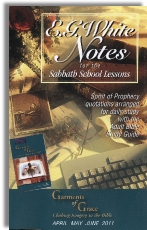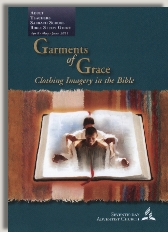|
||||||||||||||
Commentary on "The Coat of Different Colors"
Day 1: Sabbath Afternoon, April 16, 2011 - Introduction
Overview
“Garments of Grace” is the overall theme of the quarterly, and this week’s particular lesson deals with a “Coat of Different Colors”, the coat Jacob made for his special son Joseph. According to today’s lesson, this particular coat is not highlighting grace, rather it’s a symbol “of the mistakes Jacob made”. The entire week is dedicated to emphasizing the errors of Jacob and the bad consequences of one mistake leading to others. At every step people are confronted with Jacob’s and his son’s bad behavior with the intent of making the readers think twice before taking the wrong turn.
Observations
Unfortunately, by reducing his comments exclusively to human behavior and moral lessons drawn from the sins of Jacob, Joseph and his brothers, the author of the lesson doesn’t help his readers to see the greatness of God’s grace. The promising title of the quarterly doesn’t deliver in the actual content of this week's lesson.
In order to get a clear, bright, and beautiful picture of God’s grace, the eye of faith must look upward to see God’s majestic holiness. Grace is for sinners, and the greatness of God’s grace is perceived in its true dimension only when sin is perceived in its true ugliness. As long as the biblical stories are used rather like spiritual Aesop’s Fables—moral stories written for moral instruction telling what’s right and wrong through real historical examples of moral failure—the reader's innate sinfulness will congratulate him or her for being more moral than Jacob, Joseph and the others. It will only endorse the sinful satisfaction of being morally superior to the biblical characters who performed so badly. As long as sinful people compare themselves one with another, they will not get the ugliness of their sins and will never arrive at a proper perception of God’s amazing grace.
When the eye rises from the horizontal plane of human history toward God’s holiness, the real proportion of human crime emerges on the surface. Sheep may look pretty white until a snowfall makes them appear dirty in contrast with the whiteness of the fresh snow. After God’s holiness and perfection is apprehended and the sinfulness and ugliness of sin is seen in its true light, then the way is opened to understand the greatness of God’s grace in dealing with rebel sinners.
As our current lesson will carry us through the story of Jacob and sons, we can either take these lessons in a moralistic fashion, flattering ourselves for not falling into the same trap and telling ourselves to watch out lest we fall in the same way, or, after heeding the inherent warning about danger, we can look upward and see how God dealt with these people and how He fulfilled His eternal purposes of grace through a very bad series of circumstances. While the current lesson doesn’t go far enough in history to capture the moment, in the end the brothers got the message of grace and turned in repentance and sorrow for their sin against Joseph and their father. More, they realize the sinfulness of their deed in God’s eyes, which is the most important thing. Through His providence, God leads them graciously and saves them from their sin and redeems the consequences of their deeds.
With feet firmly planted in God’s sovereignty and his grace, His redeeming power, patience and long suffering, the historical material of the current lesson will appear in the proper light. Far from puffing us up in righteous pride which an exclusively horizontal plane effects, God’s involvement in the story leads us to humility in awe of His redeeming grace. “Where sin increased, grace abounded all the more” (Romans 5:20) . Jacob’s sin resulted in a lot of other sinful deeds and unforeseen bad consequences; still his family was selected to be the line which would lead to Messiah and the twelve patriarchs from whom later the twelve apostles sprang. With more and more sin on the table, God’s grace shone more abundantly.
Summary
- The Bible stories cannot rightly be used as "moral lessons".
- The Bible is to reveal God's righteousness and His mercy and grace toward sinners steeped in sinfulness.
- We must approach the Bible not to compare ourselves with other sinners but to see the holiness of God and be convicted of our own helpless sinfulness.
- Jacob was a sinner who made bad choices, but God chose Him to be the father of the twelve tribes of Israel and to be the forebear of the Messiah.
- As we see our sin with more and more clarity, we will be able to know God's grace in deeper and more profound ways.
Copyright 2011 BibleStudiesForAdventists.com. All rights reserved. Revised April 12, 2011. This website is published by Life Assurance Ministries, Glendale, Arizona, USA, the publisher of Proclamation! Magazine. Contact email: BibleStudiesForAdventists@gmail.com.
The Sabbath School Bible Study Guide and the corresponding E.G. White Notes are published by Pacific Press Publishing Association, which is owned and operated by the Seventh-day Adventist church. The current quarter's editions are pictured above.
Official Adventist Resources
Standard Edition Study Guide Week 4
Teacher's Edition Study Guide Week 4
Easy Reading Edition Study Guide Wk 4
Search the Complete Published Ellen G. White Writings
Please Support This Project


